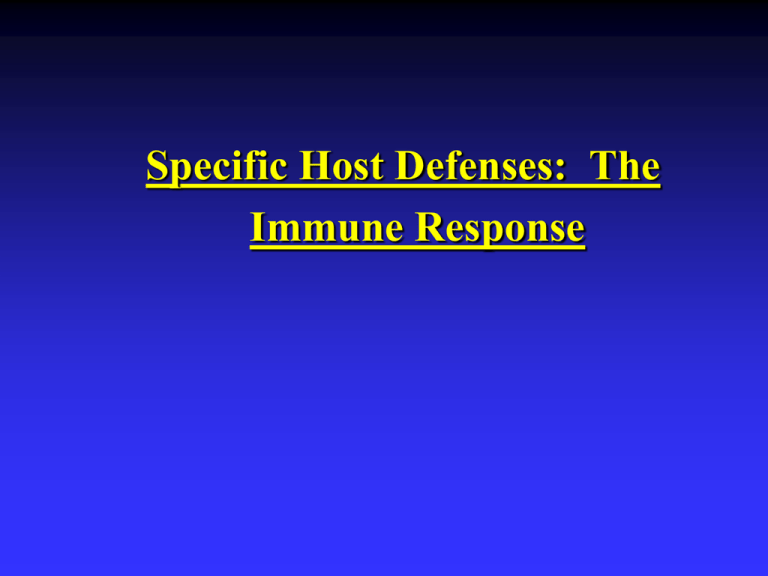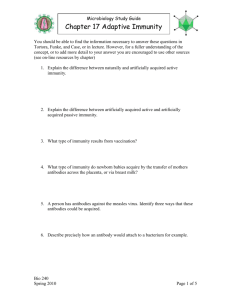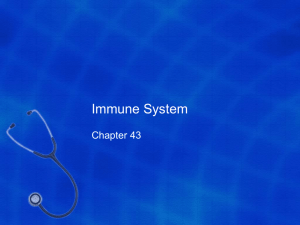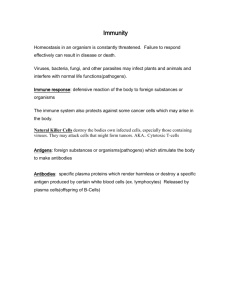Immunity notes
advertisement

Specific Host Defenses: The Immune Response The Immune Response Immunity: “Free from burden”. Ability of an organism to recognize and defend itself against specific pathogens or antigens. Immune Response: Third line of defense. Involves production of antibodies and generation of specialized lymphocytes against specific antigens. Antigen: Molecules from a pathogen or foreign organism that provoke a specific immune response. The Immune System is the Third Line of Defense Against Infection Innate or Genetic Immunity: Immunity an organism is born with. Genetically determined. May be due to lack of receptors or other molecules required for infection. Innate human immunity to canine distemper. Immunity of mice to poliovirus. Acquired Immunity:Immunity that an organism develops during lifetime. Not genetically determined. May be acquired naturally or artificially. Development of immunity to measles in response to infection or vaccination. Types of Acquired Immunity I. Naturally Acquired Immunity: Obtained in the course of daily life. A. Naturally Acquired Active Immunity: Antigens or pathogens enter body naturally. Body generates an immune response to antigens. Immunity may be lifelong (chickenpox or mumps) or temporary (influenza or intestinal infections). B. Naturally Acquired Passive Immunity: Antibodies pass from mother to fetus via placenta or breast feeding (colostrum). No immune response to antigens. Immunity is usually short-lived (weeks to months). Protection until child’s immune system develops. Types of Acquired Immunity (Continued) II. Artificially Acquired Immunity: Obtained by receiving a vaccine or immune serum. 1. Artificially Acquired Active Immunity: Antigens are introduced in vaccines (immunization). Body generates an immune response to antigens. Immunity can be lifelong (oral polio vaccine) or temporary (tetanus toxoid). 2. Artificially Acquired Passive Immunity: Preformed antibodies (antiserum) are introduced into body by injection. Snake antivenom injection from horses or rabbits. Immunity is short lived (half life three weeks). Host immune system does not respond to antigens. Serum: Fluid that remains after blood has clotted and cells have been removed. Antiserum: Serum containing antibodies to a specific antigen(s). Obtained from injecting an animal (horse, rabbit, goat) with antigen (snake venom, botulism or diphtheria toxin). Serology: The study of reactions between antibodies and antigens. Gamma Globulins: Fraction of serum that contains most of the antibodies. Serum Sickness: Disease caused by multiple injections of antiserum. Immune response to foreign proteins. May cause fever, kidney problems, and joint pain. Rare today. Duality of Immune System I. Humoral (Antibody-Mediated) Immunity Involves production of antibodies against foreign antigens. Antibodies are produced by a subset of lymphocytes called B cells. B cells that are stimulated will actively secrete antibodies and are called plasma cells. Antibodies are found in extracellular fluids (blood plasma, lymph, mucus, etc.) and the surface of B cells. Defense against bacteria, bacterial toxins, and viruses that circulate freely in body fluids, before they enter cells. Also cause certain reactions against transplanted tissue. Duality of Immune System (Continued) II. Cell Mediated Immunity Involves specialized set of lymphocytes called T cells that recognize foreign antigens on the surface of cells, organisms, or tissues: Defense against: Bacteria and viruses that are inside host cells and are inaccessible to antibodies. Fungi, protozoa, and helminths Cancer cells Transplanted tissue Antigens Most are proteins or large polysaccharides from a foreign organism. Microbes: Capsules, cell walls, toxins, viral capsids, flagella, etc. Nonmicrobes: Pollen, egg white , red blood cell surface molecules, serum proteins, and surface molecules from transplanted tissue. Lipids and nucleic acids are only antigenic when combined with proteins or polysaccharides. Molecular weight of 10,000 or higher. Hapten: Small foreign molecule that is not antigenic. Must be coupled to a carrier molecule to be antigenic. Once antibodies are formed they will recognize hapten. Epitopes: Antigen Regions that Interact with Antibodies Antibodies Proteins that recognize and bind to a particular antigen with very high specificity. Made in response to exposure to the antigen. One virus or microbe may have several antigenic determinant sites, to which different antibodies may bind. Each antibody has at least two identical sites that bind antigen: Antigen binding sites. Valence of an antibody: Number of antigen binding sites. Most are bivalent. Belong to a group of serum proteins called immunoglobulins (Igs). Antibody Response After Exposure to Antigen







